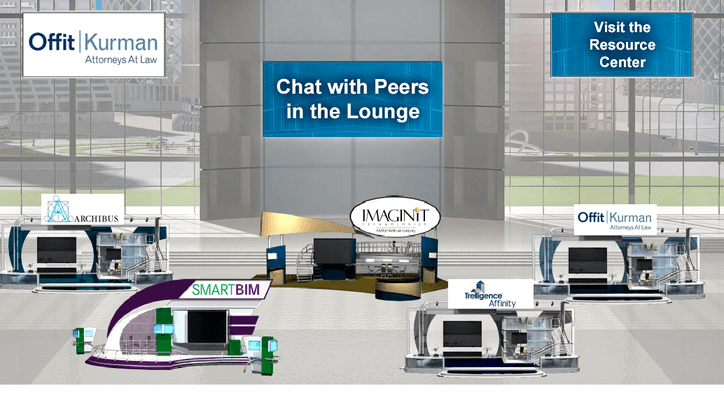Collection of webinar-style presentation, virtual show floor, chat room
CYBERSPACE—In an attempt to capitalize on the interactive capabilities offered by the Internet, professional services organization and Autodesk reseller IMAGINiT Technologies, which focuses on Revit users, held a virtual conference Feb. 17, called BIM 360, which featured a series of presentations meant to educate managers and software users about the use of building information modeling. There was also a virtual show floor with a handful of “booths” and a “lounge” where attendees could interact in chat room fashion.
The content of the event is available on demand through May 17.
The interface was basically static, with an environment set up by virtual tradeshow/webinar house Inxpo, where you could click on booths to “enter” them, which took attendees to a separate page where they could ask for private chat sessions or participate in a group chat. The Resource Center offered pdfs for download. The Auditorium offered presentations that could be experienced in real-time or on demand. Much like a real trade show, the amount of information could be overwhelming.
IMAGINiT’s Ken Flannigan, who specializes in the implementation, customization, and optimization of Revit Architecture, offered up the conference’s opening remarks.
He said the purpose of BIM 360 was to talk about “what’s holding us back” from realizing the benefits that BIM promises. “A lot of owners ask for it,” Flannigan said, “but what they’re doing with it afterward isn’t really clear to anybody.”
So, BIM 360 was designed to help everyone in the channel, from asset owners to engineers to construction managers to architects, get “better buildings, better documents, and fewer costly changes … The data is flowing through these individual stakeholders and we need to realize benefits by sharing this model.”
The majority of the event focused on new-build projects, but laser scanning and 3D capture did get its due.
Beau Turner, who identifies opportunities for IMAGINiT to create technologies, methodologies, and intellectual property, led much of the scanning discussion. In one presentation he spoke about IMAGINiT’s Scan to BIM software’s ability to integrate point clouds with Revit. The typical workflow, he said, might involve taking scan data into Leica’s Cyclone, then Cloudworks, exporting a PTS or PTX file, and then breaking that into other geometry extraction software so that you get a DWG file, which then has to be rebuilt with native Revit objects.
Then, if you want to understand the point cloud vs. what was modeled, you’ve got to export out into Navisworks, he said, as a visual tool for inspection.
“You can see where this becomes pretty time consuming,” Turner said, “and this is state of the art.”
What Scan to BIM allows you to do is work with the PTS files in a Revit environment. “We can do measurements right natively inside of Revit,” he said. “We can do geometry recognition.”
“And then you have the opportunity,” Turner said, “to understand the point cloud, validate the model as you’re creating it, and use a deviation command to find where items don’t line up with the point cloud.”
Elsewhere, in the chat room and in the chats produced in the booths, laser scanning was brought up in a few different conversations.
For example, one attendee mentioned that he had done a large Revit model of a remodel for an existing structure, saying Revit “proved quite useful to determine conflict resolution and unforeseen issues.”
Did he use a scanner?
He did not. “The remodel mentioned did not use laser-measuring as the client opted for manual verification instead,” the attendee typed. “This, of course, was only capable because we DID happen to have the original and as-built plans, which is rare.”
Another poster chimed in that “we have had a customer working with accurate point cloud data reduce overall project costs by 40 percent.”
The conversation starter agreed: “In our case, the ROI for manual conventions only out-performs scanning if the plans are available and mostly accurate, and you only manually verify suspicious areas.”
Are these kinds of conversations the same as those you would have at an in-person event? Of course not. While they could get quite substantive, and you have a record of the conversation to which you can refer back, it’s simply not possible to have the sort of nuanced conversation that you could otherwise have face to face, or even over the phone. However, a number of these conversations were likely continued with IMAGINiT employees on the phone in follow-up conversations once interest had been established.
Certainly, a number of concepts were covered in some detail, and there’s no doubt that entry-level attendees would come away much more educated for the experience. If the purpose was, as Flannigan said in his opening remarks, to keep people from getting “BIM-washed” by companies throwing around buzzwords, BIM 360 took great strides toward that goal.
Learn more about scan-to-Revit workflows with IMAGINiT at SPAR International, to be held March 21-24 in Houston. For more information, visit www.sparconference.com.






